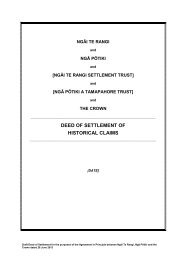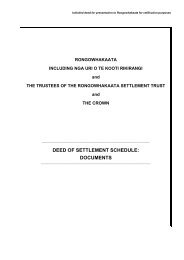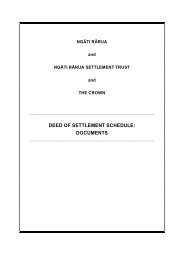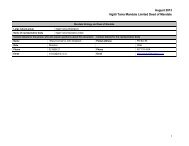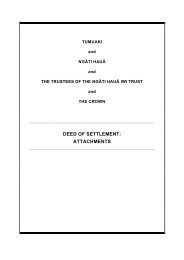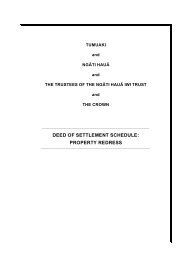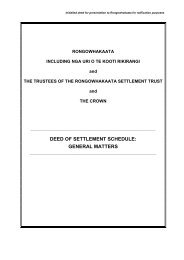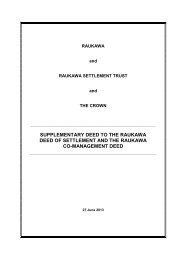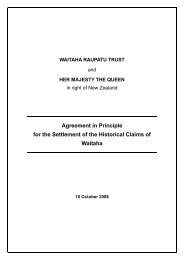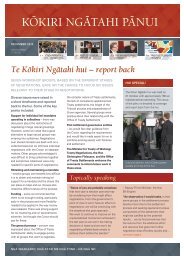Ngati Haua Deed of Settlement - Terabyte Interactive
Ngati Haua Deed of Settlement - Terabyte Interactive
Ngati Haua Deed of Settlement - Terabyte Interactive
Create successful ePaper yourself
Turn your PDF publications into a flip-book with our unique Google optimized e-Paper software.
NGĀTI HAUĀ DEED OF SETTLEMENT2: HISTORICAL ACCOUNTand aero clubs were keen to ensure that a permanent civil aerodrome was retainedafter the war.2.142 By 1946 Ngāti Hauā were continually expressing their “marked dissatisfaction” at thedelay in returning the land to them. The Native Land Court Judge who had beenpresent at the 1942 meeting with the owners expressed his view that it would ”be abreach <strong>of</strong> faith with the owners for the Government to take any step other than to carryout the bargain to reinstate and return the land.”2.143 In 1947 the Native Affairs Department expressed its view that “seeking to fulfil thepromises made to the Maori owners” had to be balanced against a matter <strong>of</strong> “nationalimportance”.2.144 During a meeting held in January 1948 the owners were informed that the land was tobe permanently taken for an aerodrome. They strongly objected, stating “thearrangement was that at the end <strong>of</strong> hostilities the land was to be returned.” One ownersaid he had agreed to the arrangement because “if the Germans came and overran theland, it would be <strong>of</strong> no use to me.” Crown <strong>of</strong>ficials made it clear that the land would betaken but <strong>of</strong>fered to provide both alternative land and some monetary compensation.2.145 In 1951 an area <strong>of</strong> just over 115 acres was formally taken under the Public Works Act.The following year the owners informed the Minister <strong>of</strong> Maori Affairs <strong>of</strong> theirunderstanding that their land would be returned to them after the war, but that this hadnot been carried out and they had yet to receive compensation. At a subsequentmeeting it was noted that “[g]reat difficulty was experienced in getting the owners t<strong>of</strong>ace the fact that the land had been taken for the Aerodrome and there was no question<strong>of</strong> getting it back.”2.146 In 1955 the Crown paid compensation <strong>of</strong> £4,163. Some land was also provided as part<strong>of</strong> the compensation, despite some opposition from local bodies. However, Ngāti Hauāhad consistently maintained their strong desire to have the lands taken for theaerodrome returned to them.2.147 Ngāti Hauā consider that the taking has been a source <strong>of</strong> ongoing grievance and hurt tothem. They consider that their willingness to prioritise national over tribal interests at atime <strong>of</strong> great crisis was taken advantage <strong>of</strong>.2.148 In 1965 the land was vested in trust in Piako County Council for the purposes <strong>of</strong> anaerodrome. That same year the Piako County Council took a further 12 acres <strong>of</strong> NgātiHauā land under the Public Works Act in order to extend the aerodrome.NGĀTI HAUĀ AND THE WORLD WARS2.149 When World War One broke out in 1914 many members <strong>of</strong> Ngāti Hauā were reluctantto fight for the Crown while their raupatu grievances remained unresolved. TupuTaingakawa explained to the Crown that his people were holding back because theyhad been aggrieved about the raupatu since the 1860s.2.150 In 1916 the Crown did not make Māori subject to the conscription for military service itintroduced for non-Māori. However, in 1917 the Crown introduced conscription forMāori living within the Waikato-Maniapoto Land District. Many <strong>of</strong> the young conscriptsfrom the Waikato refused to serve in the armed forces. Some were arrested and laterimprisoned with hard labour in Mount Eden Gaol.29



